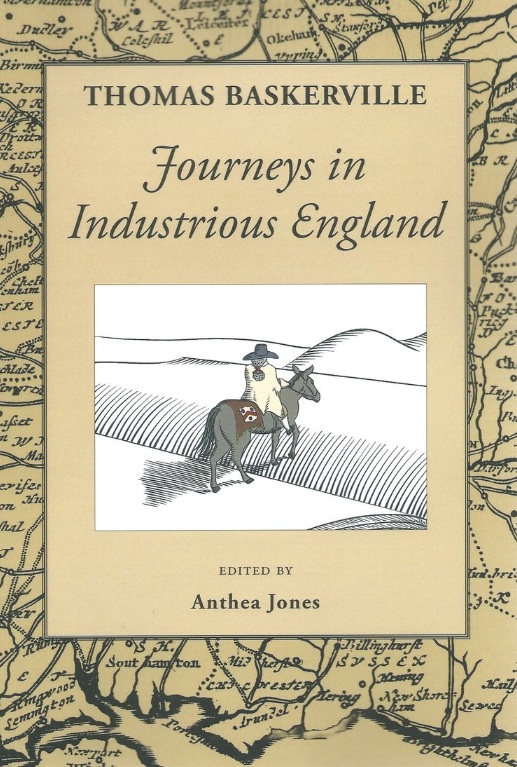Journeys in Industrious England
Journeys in Industrious England, by Thomas Baskerville, Edited by Anthea Jones, Hobnob Press, 2023, 316 pages, 22 black-and-white illustrations.
Not to be confused with the hound of Arthur Conan Doyle or with the famous 18th-century typographer, the traveller was a country gentleman and landowner (1630– 1700) who set out from his home, a mansion (demolished) near Oxford, on ten journeys by horseback to various parts of southern England, and one in the north to York and Hull. The records of Thomas Baskerville’s expeditions, made in pen and ink, fortunately survived in libraries in Oxford and London, until they were finally made available in print more than 300 years later, thanks to the work of his editor, Anthea Jones.
A local historian and frequent Context contributor, Jones is an expert on Cheltenham and its district, as well as the Cotswolds. Particularly relevant is her work on Johannes Kip, The Gloucester Engravings, that brings us three-dimensional images of the district’s major country houses. Everything is done in the new book to make Baskerville’s sometimes difficult original manuscript into an accessible modern version, complete with an index and a list of further reading.
At the end of the 1600s, the country was recovering from the civil war, with the Church of England, Oxford and Cambridge universities, cathedrals and episcopal palaces restored to the hands of the supporters of Anglicanism. Fabric was repaired, organs reinstalled, choirs re-employed and building projects resumed. It is not surprising that a man of Baskerville’s modest but sufficient wealth and his strong links with Oxford (where his father, Hannibal, had been a student with an interest in history, later passed on to Thomas) should wish to view in person these developments and set down his impressions. The colleges in both universities (the only two in England at that time) are mentioned, and unusual facts about their customs, feasts, architecture and personnel are recorded in a form that might otherwise not have survived without Baskerville’s tireless curiosity.
Baskerville is no library mouse, however, and his interests include roads, floods, bridges, forestry, the cultivation of crops, brewing and cider making, and taverns and inns where you could spend the night with merriment and feasting. Fish as food and the sport of catching trout (or sea-fishing when he was near the east coast) are a major topic throughout the ten trips, in an era when the country’s freshwaters still abounded with a wide range of fish and other edibles.
At major stopping points, or where routes intersect, the author’s impressions of towns and cities are recorded in short, amusing quips. He loved Nottingham but found Leicester ‘an old stinking town situated upon a dull river’. He lodged in various inns and country houses where his genteel hosts and their wives are described and rated rather as you might find in today’s social media or TV’s Four in a Bed. At the Red Lion, the Leicester inn of choice, he mentions its ‘gallery or dining room of great length with a long table in it to entertain people’, and goes on to describe in detail ‘the plaister like that of Paris’ and the patterns it included. Elsewhere, as at Hull, he mentions features that might well now have disappeared, such as the city walls and the fortifications installed to defend its open location on the east-facing estuary. Naval wars with the Dutch still went on, and his interest in them compares with his great contemporary, the diarist and naval administrator, Samuel Pepys.
For those with knowledge of the vital years of the late 1600s, on the verge between pre-modern and truly modern, this new edition from Hobnob adds a vital item to its useful list of specialist but highly practical publications. It is a tribute to Anthea Jones’s editing skills. Other readers will find it an intriguing introduction to a part of history at once remote and yet familiar enough to enjoy treading the same ground and seeing the same sights.
This article originally appeared as ‘Horseback view’ in the Institute of Historic Building Conservation’s (IHBC’s) Context 180, published in June 2024. It was written by Graham Tite, heritage consultant to Rother Council, East Sussex.
--Institute of Historic Building Conservation
Related articles on Designing Buildings Conservation.
IHBC NewsBlog
IHBC Context 183 Wellbeing and Heritage published
The issue explores issues at the intersection of heritage and wellbeing.
SAVE celebrates 50 years of campaigning 1975-2025
SAVE Britain’s Heritage has announced events across the country to celebrate bringing new life to remarkable buildings.
IHBC Annual School 2025 - Shrewsbury 12-14 June
Themed Heritage in Context – Value: Plan: Change, join in-person or online.
200th Anniversary Celebration of the Modern Railway Planned
The Stockton & Darlington Railway opened on September 27, 1825.
Competence Framework Launched for Sustainability in the Built Environment
The Construction Industry Council (CIC) and the Edge have jointly published the framework.
Historic England Launches Wellbeing Strategy for Heritage
Whether through visiting, volunteering, learning or creative practice, engaging with heritage can strengthen confidence, resilience, hope and social connections.
National Trust for Canada’s Review of 2024
Great Saves & Worst Losses Highlighted
IHBC's SelfStarter Website Undergoes Refresh
New updates and resources for emerging conservation professionals.
‘Behind the Scenes’ podcast on St. Pauls Cathedral Published
Experience the inside track on one of the world’s best known places of worship and visitor attractions.
National Audit Office (NAO) says Government building maintenance backlog is at least £49 billion
The public spending watchdog will need to consider the best way to manage its assets to bring property condition to a satisfactory level.

















